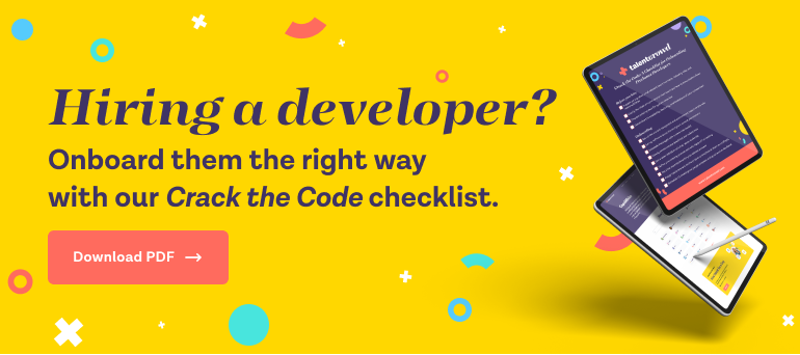What do MEAN and MERN mean, anyway? Even long-time developers can get overwhelmed when they see various technology terms. Stack options can be tricky, and sometimes it's hard to know which framework will work best for your project. If you are looking for information on technology terms, their meanings and uses, and how to keep them straight, you've come to the right place!
This article will review technology terms such as full stack, MEAN stack, and MERN stack. We'll discuss the differences between MEAN and MERN and how each is used. In addition, we'll offer general guidance on choosing which technology stack will best achieve the project goals. Lastly, we'll throw in a helpful tip on where to find the perfect stack developer for your team.
So, let's dive right into MEAN stack vs MERN stack.
Web Development Focuses
Web developers can work on three areas when writing code: front-end, back-end, or full stack.
Front-End:
Front end refers to the development and programming of code that creates features of a website, specifically those which will be seen and used by the client. Front-end code runs everything that a user can interact with and see when they click on your site.
Back-End:
This type of code refers to the hidden features of a site. Equally as important, the back-end code is responsible for running the program or application but is not seen or accessed by the user.
Full Stack:
The combination of developing both front-end and back-end code is referred to as "full stack." A full stack developer is someone who can maintain both client and server software.
Tech Stacks Explained
What is a Tech Stack?
A stack combines reliable frameworks, technology, and programming languages to create an effective solution for building things like mobile and web applications.
Think of tech stacks like a build-your-own burger. You combine several great ingredients, and “stack” them on top of each other to create a customized item.
Example:
Here's an example to better help you visualize what exactly we're talking about. Let's call our hypothetical example, "The Streaming Service Burger.”
Top Bun: User Interface or how viewers interact with the streaming service. (front-end code)
Cheese: The middle man between the user side and the server side. (connects front-end code with back-end).
Patty: Server Code or how you request data to choose a show. (back-end code)
Bottom Bun: How the program remembers your settings and preferences. (database)
In this example, the ingredients combine to create a user-friendly UI and functional back-end code that results in a positive viewing experience.
Most Popular Technology Stacks
Now that we know "full stack" refers to the entire development process from front-end to back-end, and we can visualize how combining languages can create an effective framework, let's discuss types of stack frameworks within a full stack process.
You need to know two technology stack terms if you want to keep up with the long-time programmers: MEAN stack vs MERN stack.
MEAN Stack
What does MEAN stand for?
MEAN is an acronym for programming languages. It stands for:
MongoDB (Botton Bun: Database)
Express JS (Cheese: Middle Man)
Angular (Top Bun: User Interface)
Node JS (Patty: Server Code)
What is MEAN used for?
Arguably the most popular framework in development, MEAN is used primarily to build powerful, dynamic web applications.
MEAN stack's defining characteristic is Angular. MEAN developers work in Typescript and interject JS into HTML, using more than one language.
MEAN stack is great for enterprise-level projects.
Characteristics of MEAN Technology Stack:
Take a look at some of the reasons software development teams would use MEAN stack technology:
- Effective testing: MEAN stack code is easy to test because it comes with pre-built testing tools. This pre-configured framework means bugs can be cleared up more easily.
- Model view controller: MVC architecture is an organization technique that means code isn't dependent on other code. This allows for easier debugging as every line stays in its lane.
- Bidirectional data flow: When data is changed on the front end, those changes get reflected in the model or back end. Vice-versa, when changes are made to data on the back-end, the back-end notifies the UI and reflects the changes.
- Isomorphic coding: Within the MEAN stack framework, code can easily be translated from one language to another. The benefit of this is that web developers can share code instead of having to write separate programs for different users.
- Open-source framework: Web developers have access to resources through open-source frameworks. MEAN stack uses Angular, which is built and backed by Google. The open-source framework results in a knowledgeable network where devs can use others' research to solve their coding questions.
Disadvantages of MEAN stack
- There is a steeper learning curve to Angular than React JS.
MERN Stack
What does MERN stand for?
Another acronym of programming languages, MERN stands for:
MongoDB (Bottom Bun: Database)
Express JS (Cheese: Middle Man)
React JS (Top Bun: User Interface)
Node JS (Patty: Server Code)
What is MERN used for?
Uses include mobile app development such as calendars, to-do lists, social media ads, and more. MERN stack is typically used for quicker, smaller projects in web app development, mobile apps, and updates.
MERN's defining characteristic is its use of React JS-- making the requirements for this stack one language all across the board: JavaScript.
MERN stack is great for start-ups and projects with a quick turnaround.
Characteristics of MERN Technology Stack
Here are some reasons a development team would choose MERN stack:
- JS library: Uses React JS library and is backed by Facebook.
- Simple framework: The consensus among developers is that MERN stack is easier to learn than MEAN stack. Developers only really need to learn JavaScript. Once you know JS, you can easily manage front-end code, back-end, and databases.
- Rapid code development: Because the entire framework is based on JS, development is simple and fast.
- Open source framework: Similar to MEAN, MERN framework is easily modified through the open-source community.
- Unidirectional data flow: Also known as one-way data flow. This characteristic means that back-end data changes will not be reflected on the front end.
- Lower development cost: MERN stack is a cost-effective coding solution. Open-source support combined with reduced learning time means that companies save time and money.
Disadvantages of MERN Stack
- MERN is not the best option for managing larger projects, as React can't always keep up with Angular in bug prevention.
Major Differences Between MEAN Stack VS MERN Stack
Both MEAN and MERN offer great scalability and security.
MEAN Stack:
- Uses Angular, which Google created
- Better for bigger/more complicated projects and enterprise-level projects
- Bidirectional data flow
- Steeper learning curve
MERN Stack:
- Uses React, which Facebook created
- Better for faster/smaller projects like apps
- Unidirectional data flow
- Faster development with a lower learning curve
How to Choose
Both MEAN and MERN are effective. The decision comes down to preference and your unique project needs. To help you decide which tech stack would be best for your project, ask yourself the following questions:
What are my project requirements?
What is the scale of the project?
What type of project am I creating?
What's my timeline?
Once you know your answers, you can choose the framework.
Who to Hire
As mentioned, MERN stack has proven to be the most cost-effective and requires less formal training than the MEAN development process. Then again, depending on the size and scope of your project, hiring a MEAN developer might be the way to go. No matter which framework you choose, you need to hire people who know what they're doing.
So, how do you find these highly-skilled stack developers? Hiring a recruiting agency such as TalentCrowd will save you time and maximize your search results.
TalentCrowd aims to help employers scale technology teams at lightning speed. Their digital talent platform provides employers with highly-vetted technology talent. Answer a few online questions and let the TalentCrowd hiring team help find the right match for your business needs. Your results will connect you with individuals with the qualifications you need and who are ready to start coding.
Summary
MEAN and MERN stacks are popular frameworks in web and mobile app development.
MEAN stack uses Angular and is better for enterprise-level projects and in-depth websites.
- Main advantage: Highly effective due to bidirectional data flow, MVC architecture, and easy testing.
- Main disadvantage: Steep learning curve.
MERN stack uses React JS, allowing developers to quickly code small projects.
- Main advantage: Lower cost, rapid development speed, and easier to learn.
- Main disadvantage: React JS ranks lower in error prevention.
Key Takeaways
Both MEAN and MERN are effective stacks. When choosing which framework is best for you, consider project requirements, scale, type, and timeline. Ultimately, coding preferences and the project's functional requirements will be the deciding factors.
No matter which you choose, TalentCrowd can help your team hire the right developer to get the job done. To learn more about how to find and hire the best talent available, visit talentcrowd.com.


.jpg?width=352&name=pexels-cottonbro-5989933(1).jpg)

